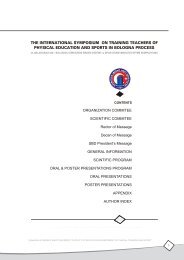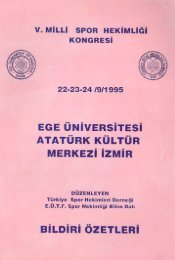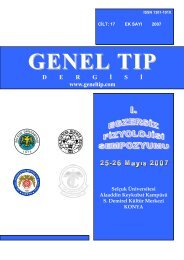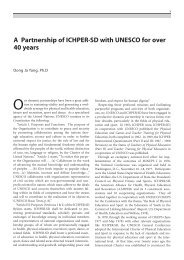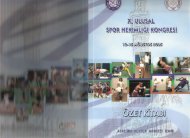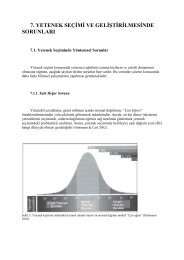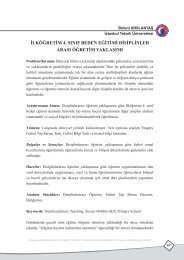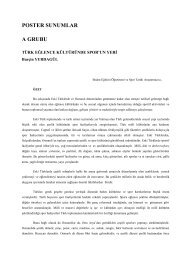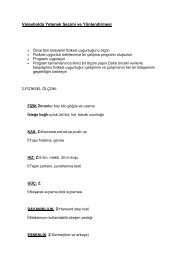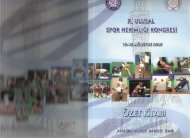KARDÄ°YORESPÄ°RATUVAR EGZERSÄ°Z TESTLERÄ° ... - Spor Bilim
KARDÄ°YORESPÄ°RATUVAR EGZERSÄ°Z TESTLERÄ° ... - Spor Bilim
KARDÄ°YORESPÄ°RATUVAR EGZERSÄ°Z TESTLERÄ° ... - Spor Bilim
You also want an ePaper? Increase the reach of your titles
YUMPU automatically turns print PDFs into web optimized ePapers that Google loves.
7.ULUSLARARASI SPOR BİLİMLERİ KONGRESİ27-29 EKİM 2002KONGRE - PANELLERthrough the system.Table 1. Maximum number of players that can be registered and games that can be played at a Football Academy.Maximum Numberof Players (ineach age group)Maximum Numberof gamesU 9 – U 12 U 13 – U14 U 15 – U16 U 17 – U 2140 30 20 1524 (plustournaments)24 (plustournaments)24 (plustournaments)28 (plustournaments)Contact between coaches is dependent on age. Coaching sessions for age groups between 9 and 16take place in the evening (between 1700 and 2100 hours) following the completion of school. Age groupsbetween 9 and 12 attend sessions twice per week; 13 – 16 year olds attend three sessions in total. Thecompletion of compulsory education (age 16) permits full-time training (approximately 6 hours per day) for thoseselected.The principles that guide coaching practice are similar for all groups. Key factors included in theorganisation of coaching sessions include the maximising of ball contact, the use of specific match drills tofacilitate learning and the completion of pre-determined periods of free unhindered match-play. Theoperationalisation of these principles does, however, change according to the age group in question. The initialfocus of coaching is on the development of fundamental game skills such as dribbling, control, heading, passingand shooting. These skills are then contextualised within more game specific situations by including otherplayers (both team mates and opponents), more stringent rules and regulations (e.g. offside) and confinedrelevant areas of play (e.g. the penalty area). Basic elements and concepts of team play and strategy isintroduced to players by the age of 14. This practice provides the foundation for the systematic tactical andtechnical preparation that is the focus for 17 – 21 year olds.The club‘s responsibility for the growth of the players in its Academy also extends to their psychologicaland sociological development. The high attrition rates at each age necessitate a commitment to development inits broadest sense. This is especially the case for the young full-time professional players who have yet tosecure their long-term future with the club. Further education is a compulsory aspect of their weekly schedule.These educational programmes provide additional career opportunities if they fail to progress at the club.The development of players is further supplemented by a programme of matches that is organisedbetween different Academy teams by The Premier League. The type and number of these games is strictlygoverned by principles proposed by the Football Association and The Premier League (see Table 1). Smallsidedgames are played between the ages of 9 - 11. Such games have the advantages of maximising thenumber of ball contacts for each player and reducing the stress associated with matches. Eleven-a-side gamesare introduced when it is considered that such a match structure will facilitate development.A comprehensive monitoring process is carried out throughout the years that players are registered withthe Academy. Soccer-specific evaluations are carried out by the coaches using criteria that are agreed by allAcademy staff. Players are evaluated on a range of abilities including their technical play, understanding of thegame, their attitude and enthusiasm and athleticism. Such evaluations are performed following everycompetitive match and at regular intervals throughout the season.Comprehensive medical records are also maintained for each player. These highlight the type, extentand treatment of any injuries that each player may have experienced. Over time these evaluations form asubstantial database on each player within the Academy structure. This database of information can then beused by coaches to review all aspects of the players development enabling an informed decision to be made on379



